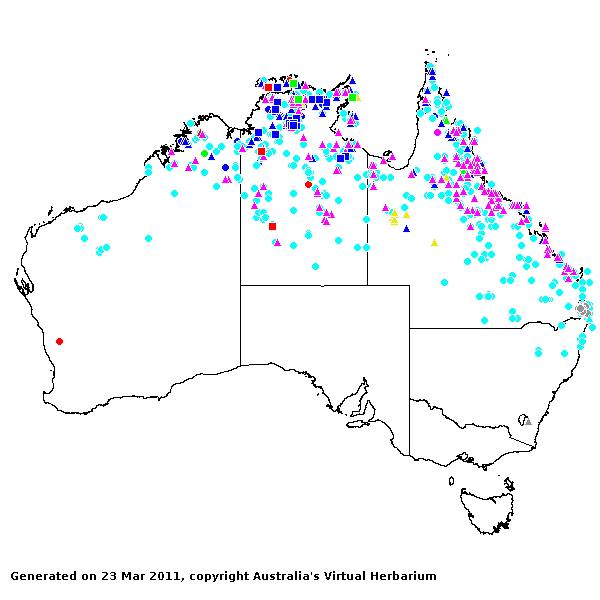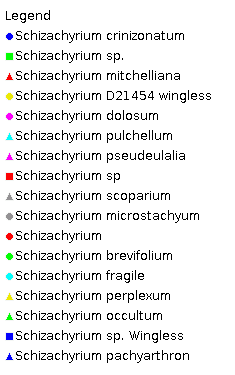Schizachyrium Agrost. Bras. 331 (1829).
Derivation:. From Greek schizen (to split) and achuron (chaff), alluding to the bilobed lemma of the sessile spikelet.
Taxonomic revisions, nomenclatural references:. S.T.Blake, Contr.Queensland Herb.17: 2–29 (1974); B.K Simon, Austrobaileya 3: 90 (1989).
Key references (keys and floras):. G.Bentham, Flora Australiensis 7: 535 (1878) as Andropogon in part; C.A.Gardner, Flora of Western Australia 1 Gramineae 333 (1952); J.W.Vickery, Flora of New South Wales, Gramineae 19: 49–50(1961); E.E.Henty, Manual Grasses New Guinea 169–170 (1969); M.Lazarides, Tropical Grasses S.E. Asia 69–70 (1980); M.Lazarides, Flora of Central Australia 490 (1981); J.C.Tothill and J.B.Hacker, Grasses of Southern Queensland 368–370 (1983); B.K.Simon, Flora of the Kimberley Region 1213, 1215–1216 (1992); B.K.Simon, Key to Australian Grasses 154–155 (1993); S.W.L.Jacobs and C.A.Wall, Flora of New South Wales 4: 443 (1993); D.Sharp and B.K.Simon, AusGrass (2002); S.W.L.Jacobs, R.D.B.Whalley & D.J.B.Wheeler, Grasses of New South Wales, 4th ed, 364–365 (2008).
W.D.Clayton & S.A.Renvoize, Genera Graminum (1986), genus (46).
Native. About 60 species, from tropical regions. 8 species in Australia, WA, NT, Qld, and NSW. Also New Guinea and Malesia.
Habit. Annual or perennial, rhizomatous or stoloniferous or tufted or decumbent. Culms woody and persistent (rarely, and never tall), or herbaceous. Leaf blades narrow. Ligule a fringed membrane (short).
Inflorescence. Inflorescence a single raceme or paniculate (of single racemes, these sometimes solitary but usually in a spatheate false panicle), a spatheathe panicle, spatheate, racemes single, not in tight heads, a compound pseudo-inflorescence. Spikelet-bearing axes peduncled racemes, with heteromorphic spikelets, solitary (in their spathes, but often fascicled), disarticulating at joints.
Spikelets. Spikelets dorsally compressed (or subterete below and compressed between the internode and the pedicel, lanceolate to linear), 2 flowered, with 1 fertile floret, paired, sessile and pedicelled, in pedicelled/sessile combinations; sessile spikelet with lower incomplete floret. Fertile spikelets falling with glumes (and the joint).
Glumes. Glumes more or less equal, long relative to adjacent lemmas, awned (the upper, rarely) or awnless, dissimilar (the lower bicarinate, the upper thinner and naviculate). Lower glume two-keeled (the keels not winged, but excurrent as teeth or mucros), convex on back to flattened on back, relatively smooth, 3–13 nerved (with several between the keels). Upper glume 1–3 nerved.
Florets. Lower incomplete floret(s) sterile. Lemmas awnless, 2 nerved, similar in texture to fertile lemmas (hyaline, often purple), not becoming indurated. Fertile florets 1. Lemmas often stipitiform, less firm than glumes (hyaline), not becoming indurated, usually incised (rarely merely prolonged into the awn, without teeth), deeply cleft (often deeply bifid) or not deeply cleft, awned, 1–3 nerved, glabrous. Awns 1, from a sinus or apical, geniculate, hairless (glabrous), about as long as body of lemma or much longer than body of lemma (usually short). Palea present or absent (usually), when present, very reduced (to a minute, hyaline scale), nerveless. Callus short, blunt. Lodicules 2. Stamens 1–3. Grain compressed dorsiventrally (or subterete). Hilum short. Embryo large. Pedicels free of rachis. Pedicelled spikelets present, different from sessile spikelet.
Kranz Anatomy. C4, biochemical type NADP-ME (1 species).
2n = 20, 30, 40, and 50.
Habitat. Helophytic, mesophytic, xerophytic. Savanna, rarely sandy beaches or dunes. Species of open habitats.
Classification. Panicoideae; Andropogoneae.
Notes. The genus is very closely related to Andropogon sect. Leptopogon, being distinguished by its single racemes. The intercarinal nerves and fimbriate internode tip serve to separate it from the few species of Andropogon which also have single racemes (Clayton and Renvoize, 1986).
Types Species. S. brevifolium (Sw.) Nees ex Buse.
Biogeographic Element. Clifford & Simon 1981, Simon & Jacobs 1990: Gondwanan.


